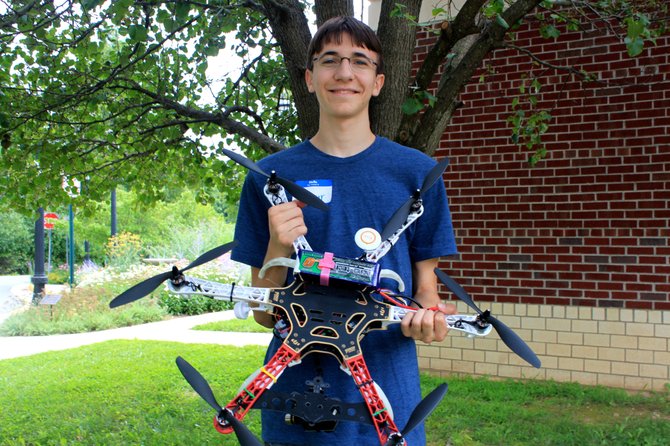Arthur Tisseront, 16-year-old intern for the Kashmir World Foundation, is the “drone expert” for the workshop. Photo by Reena Singh.
While many teens are spending the summer socializing, a handful of them were tinkering with wires and 3D printing.
Kashmir World Foundation held a Build-A-Drone workshop at Great Falls Library Friday to help find a solution for rhinoceros being poached in Africa.
The Wildlife Foundation Unmanned Aerial Vehicle Challenge, a worldwide challenge, currently has 138 teams competing for a solution. However, the nature of the workshop was not competitive.
“I started the Da Vinci Challenge to get students interested in science, engineering and art,” said KWF founder Aliyah Pandolfi. “We wanted to do a hands-on workshop, because that’s different than having them listen or watch a video.”
The four-day workshop has students create a quadcopter with additions like a camera so they can shoot a video at events or just for fun.
THE WORKSHOP was targeted for ages 13 and up, but there were some students who were younger. Mark Mahdessian, 11, Great Falls, wanted to join the workshop when his 14-year-old brother, Leo, signed up.
“When he was signing up, he asked me if I wanted to come with him,” said Mark. “I like that you have hands-on experience with building the stuff.”
Leo said he has been interested in drones and electronics for a while. When he found out about the workshop, he knew it was right up his alley.
“I got interested in quadcopters after flying one at his baseball game,” Leo said, gesturing at his brother. “I really wanted to build one. I really enjoy electronics and computers. I have a passion for building stuff.”
Rather than using kits that already have all the quadcopter pieces in it, Pandolfi had the participants use 3D printers to create parts that fit the size they wanted their drone to be.
“This is to help them understand the internals of it,” she said.
She said that, although drones have had a negative connotation, they can be used to spot poachers before they hurt animals. At Kruger National Park in Africa, she said, poaching has created a crisis. Just last year, 1,004 rhinos were killed for their horns, which can fetch $100,000 in the black market.
“The number of poaching incidents keeps increasing,” she said. “This allows students to understand global issues and the possible impact of these drones.”
She also wants the workshop participants to understand the safety regulations and ethics of the machines they are building. At the next class, a representative from the Federal Aviation Administration is coming to the class to talk about the rules of flying in the area and safety procedures.
THE DRONE EXPERT of the workshop, Arthur Tisseront, is a rising junior at Thomas Jefferson High School For Science and Technology and a resident of Great Falls.
“I started playing with drones a while ago when they were a new thing,” the 16-year-old intern said.
He showed a hexacopter - that means six propellers - to the workshop participants that took him more than two weeks to put together.
“I think in the next 12 months, drones will be scoping out poachers,” he said. “That’s one of the biggest applications it could be used for.”
He plans on starting a small business as soon as the Federal Communications Commission puts out their new flight regulations next year. He sees drones becoming more commonplace in the future.
“Look to the future,” he said. “There’s going to be a lot of drones in it.”

